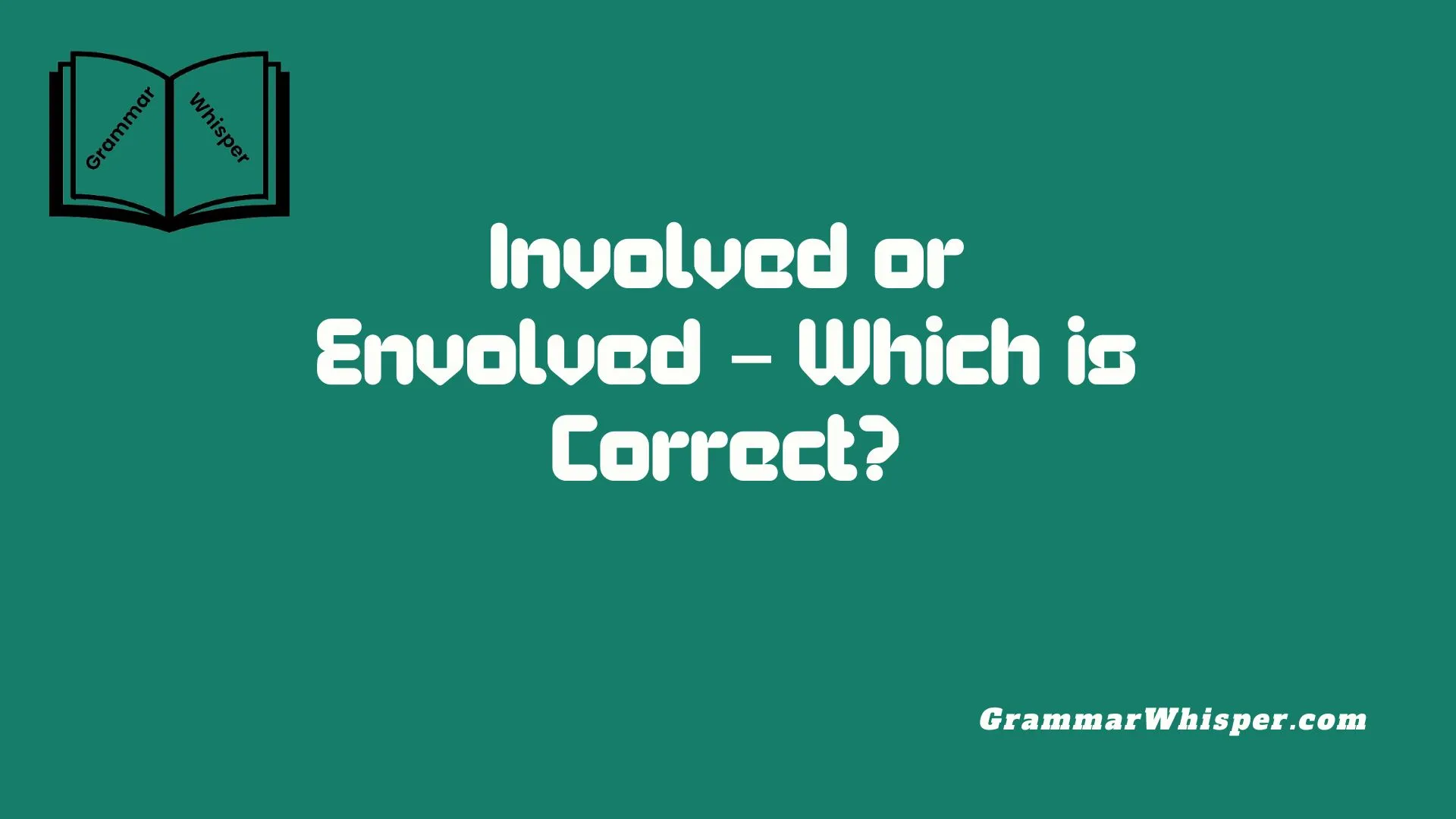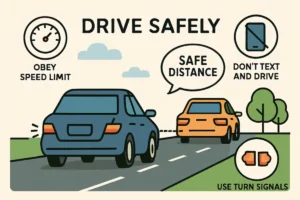When learning English, it’s easy to see why many people get confused by similar-looking words. One of the most common pairs I’ve seen learners struggle with is “involved or envolved.” I remember early in my writing journey, I too would mistakenly think “envolved” looked righ – especially in informal communication. But here’s the truth: despite how familiar it might seem, “envolved” is not a valid word in English. I’ve written a blog post to help clarify this, because understanding the difference plays a crucial role in using language effectively.
In countless contexts, the word “involved” is used to show connection, participation, or complexity. Once I took a deep dive into this topic, I realized that the mistake often comes from how the word sounds when spoken, not how it’s written. So, we’ll explore the why, the how, and where this misspelling happens most. This article is here to guide you in choosing the right word, using it correctly, and becoming more confident in your writing. You’ll soon see that knowing what’s correct among all those tricky words is part of building stronger language knowledge, and this post helps you get there.
Understanding the Correct Usage: Involved vs. Envolved
The difference between “involved” and “envolved” might seem subtle, but understanding their proper usage is key to achieving clarity in communication. Let’s break it down:
- Involved is an adjective and verb in the English language, meaning to be engaged in an activity or situation, or to have a personal connection with something or someone.
- Envolved, on the other hand, is not a word in English at all. The confusion likely arises from the similarity in sound between the prefix “in-” and “en-“, but “envolved” is simply a misspelling.
Understanding these distinctions helps ensure that you are not misusing language in both written and spoken communication.
Explaining the Definition and Use of “Involved”
The word involved has several meanings and uses. It is most commonly used to express engagement, complexity, or emotional participation. Here are the main ways “involved” is used:
- Adjective Usage: When describing someone or something that is engaged in a particular activity or situation.
- He was deeply involved in the project, contributing at every stage.
- Verb Usage: When referring to the act of becoming engaged or participating in something.
- She involved herself in the debate to offer her perspective.
When Involved Describes Complexity
In certain situations, involved refers to something that is complex or intricate. This is often used when discussing tasks, issues, or subjects that require detailed attention.
- The project became more involved as we moved forward, with multiple stakeholders and varying opinions.
Emotional or Relational Involvement
Involved also carries an emotional or personal connotation. When someone is emotionally invested in a situation or relationship, they are described as being “involved.”
- They became involved with each other after several years of friendship.
Why “Envolved” is a Common Spelling Mistake
The confusion between “involved” and “envolved” often arises due to the phonetic similarity of the two words. The prefix “in-” (which often means “into” or “not”) is commonly confused with “en-” (which often means “cause to” or “put into”).
Since “involved” sounds like it could have an “en-” prefix, people mistakenly write “envolved,” thinking it’s the correct spelling. The widespread nature of this mistake is probably the result of similar-sounding words, but in fact, “envolved” is incorrect.
Examples of Misspellings:
- Incorrect: She was envolved in the event planning process.
- Correct: She was involved in the event planning process.
Cambridge Dictionary’s Clarification on the Matter
According to the Cambridge Dictionary, “envolved” is not listed as a valid English word. When in doubt, it’s always best to refer to trusted sources like the Cambridge Dictionary, which can confirm that “involved” is the only correct option.
Cambridge’s online dictionary and other authoritative sources are invaluable when it comes to clearing up confusion around common spelling and grammatical errors. This reinforces the idea that relying on established dictionaries ensures precision in communication.
The Grammatical Role of “Involved” in Sentences
Involved serves two primary grammatical roles: it can act as an adjective or a verb. Let’s look at both:
As an Adjective
- Describes someone or something that is part of a situation or activity.
- The involved parties reached a consensus after hours of negotiation.
As a Verb (Past Tense of “Involve”)
- Refers to the act of engaging or participating.
- He involved his team in every phase of the project.
In both cases, “involved” expresses engagement, commitment, or complexity.
Diving Deeper: The Various Meanings of “Involved”
Involved is a versatile word that can describe a variety of scenarios, from intricate projects to personal connections. Here’s a deeper dive into how involved works in different contexts:
Complexity
- Involved can mean that something is difficult or requires careful attention because it has many parts or layers.
- The involved nature of the task meant that only experts could handle it.
Emotional Engagement
- When used to describe relationships or personal commitments, it refers to emotional involvement.
- She felt deeply involved in the cause.
Active Participation
- Involved can also denote active participation, especially in group efforts or collective activities.
- He was actively involved in the community outreach program.
When “Involved” Describes Complexity
As mentioned earlier, involved can describe something that is detailed, complex, or difficult to understand. This sense is especially common in academic writing, technical contexts, and discussions of intricate topics.
- The instructions were involved, requiring several readings to fully understand.
- The involved nature of the case meant that it took weeks to resolve.
In these examples, “involved” conveys the idea that the subject requires more than just a casual look to grasp its entirety.
The Emotional and Relational Aspects of Being “Involved”
One of the more intimate uses of involved relates to emotional engagement. When someone is “involved,” it suggests they are emotionally or personally committed to a situation, person, or cause. This use is particularly common when discussing relationships or community engagement.
- They were emotionally involved in the discussion about social justice.
- She felt deeply involved with the family project.
This usage emphasizes that the person is not just participating physically but also connecting on a deeper, emotional level.
Professional and Hobbyist “Involvement”: A Sign of Engagement
In both professional and hobbyist contexts, involvement indicates a high level of engagement. Whether in the workplace or in personal activities, being “involved” signifies dedication and active participation.
- He is involved in several industry groups, focusing on innovation in tech.
- She’s involved in a local photography club, sharing her passion with others.
In these contexts, “involved” is a sign of an individual’s commitment to their field, whether for personal development or professional networking.
Real-life Examples: Incorrect vs. Correct Usage
To better understand the difference between “involved” and “envolved,” let’s look at some real-life examples of incorrect versus correct usage.
| Incorrect | Correct |
| He was envolved in the investigation. | He was involved in the investigation. |
| She became envolved with the project. | She became involved with the project. |
| The team was envolved in the debate. | The team was involved in the debate. |
These examples show how “envolved” is simply a typographical error, and using “involved” instead conveys the intended meaning correctly.
The Prevalence of “Involved” Over “Envolved” in Literature
In literature, journalism, and formal writing, “involved” is far more prevalent than “envolved”. The correct usage of “involved” can be seen across various reputable sources, ranging from academic papers to news articles.
Data from Language Usage:
- Books & Scholarly Articles: A search for “involved” in literary and scholarly articles will show a significant dominance of the word.
- News Media: Major outlets, including The New York Times, BBC, and others, use “involved” thousands of times more often than “envolved.”
Final Insights: Why Choosing the Right Word Matters
Choosing the correct word – involved over envolved – is essential for maintaining language accuracy and credibility. Misusing words, especially in professional or academic contexts, can detract from the clarity of your communication.
Additionally, using the correct word demonstrates attention to detail, which is critical for maintaining professionalism in writing.
Here are a few key takeaways:
- Involved is the correct word to use, while envolved does not exist.
- Mastering the usage of “involved” helps ensure clear communication and avoid misunderstandings.
- Keep practicing proper language skills to enhance your writing and speaking proficiency.
FAQs
Is “envolved” a valid word in English?
No, “envolved” is not a valid word in the English language. The correct term is “involved”.
What is the difference between “involved” and “envolved”?
“Involved” refers to engagement, complexity, or emotional participation. “Envolved” is simply a common misspelling.
How can I avoid the common mistake of writing “envolved”?
To avoid this mistake, remember that the correct word is “involved”. If you’re unsure, always double-check using reliable sources like dictionaries.
Why is “involved” preferred over “envolved” in literature and professional writing?
Involved is the grammatically correct term and is widely used in literature, academic writing, and professional contexts to express engagement, complexity, or emotional connection.
Can “involved” be used to describe emotional connections or just physical actions?
Yes, “involved” can describe both emotional connections and physical actions. It encompasses a wide range of engagements, from personal relationships to complex professional tasks.











